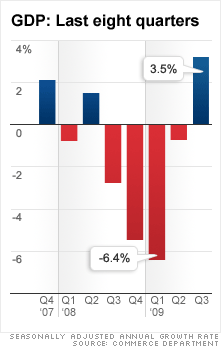Economy finally back in gear
Government says GDP grew 3.5% in third quarter, ending a year-long string of declines and coming in better than forecasts.

NEW YORK (CNNMoney.com) -- The U.S. economy grew at a 3.5% annual rate in the third quarter, ending a string of declines over four quarters that resulted in the most severe slide since the Great Depression. But some economists raised doubts about how long such strong growth can last.
The increase in GDP, reported by the government Thursday morning, was slightly better than expectations. Economists surveyed by Briefing.com had forecast 3.2% growth in gross domestic product, the broadest measure of the nation's economic activity. The economy shrank at a 0.7% rate in the second quarter.
The positive GDP report is one more sign that the economy has likely pulled out of the deep recession that started in December 2007.
The reading by itself doesn't mark an end to the recession; the economy actually grew in the second quarter of 2008. (The National Bureau of Economic Research, which officially dates the beginning and end of recessions, is not expected to declare that the current recession has ended until sometime in 2010.)
But the stronger-than-expected growth is likely to lead more economists to declare that the economy hit bottom earlier this year and turned higher at some point in the summer.
Businesses continued to reduce inventories, but by a much slower pace than in the past. That helped to lift the overall GDP growth rate by nearly a full percentage point.
The slashing of production in jobs in the face of weak demand has been one of the strongest drags on the economy during the past four quarters.
Robert Brusca, an economist with FAO Economics said that the fact that businesses are still cutting inventories "tells us that the economy has not yet turned any corner very sharply."
But Bill Hampel, chief economist of the Credit Union National Association, said it's encouraging that the economy was able to grow at all without businesses actually rebuilding inventory. He said that is a positive sign of growth yet to come.
"The inventories still need to be replenished, and when they are, it will give us an even bigger lift," he said. "I don't think this report is a sign of a booming economy, but it does seem to be setting down roots that will be sustainable."
A rebound in auto sales, which were helped by the government's Cash for Clunkers program, also provided a boost to GDP. The economic stimulus package, with public works projects and aid to state and federal governments, boosted growth as well.
Christina Romer, chair of the White House's Council of Economic Advisors, said in a statement that stimulus added between 3 and 4 percentage points to growth this quarter, suggesting that the economy would have shown little or no growth without the bump from government spending.
Romer also noted that the swing from a 6.4% rate of decline in GDP during the first quarter to the third quarter's 3.5% rise is the biggest six-month turnaround in the economy since 1980.
"However, this welcome milestone is just another step, and we still have a long road to travel until the economy is fully recovered," she said.
The fact that much of the gain was from these short-term programs raises some concerns about whether the economy can keep growing over the next few quarters.
There were other signs of growth that were more encouraging, however. Consumer spending rose at a 3.4% rate, the biggest increase in nearly three years. Spending by consumers accounts for more than two-thirds of the nation's economic activity.
"Final sales continue to improve and this provides the underlying demand for growth," said John Silvia, chief economist for Wells Fargo Securities. "Our expectations are for moderate growth, not a boom."
But David Rosenberg, chief economist and strategist for investment bank Gluskin Sheff, said that the recent weak readings on consumer confidence show that only economists think the recession is over.
"The man on the street sees it a little differently," he said. And consumer concerns about continued economic hard times are likely to put a crimp on the spending needed to get the economy moving again.
"There is going to be some very tough slogging ahead," he said.
Sung Won Sohn, an economics professor at California State University Channel Islands, added that it is unreasonable to expect more big increases in consumer spending going forward -- especially if job losses continue to mount.
"Consumers are in no position to go on another spending spree," he said. "Potential employers want to make sure that the economic recovery will be sustained before hiring people. Without jobs, consumers are unlikely to open their wallets."
Housing, which has been a drag on the economy since the popping of the real estate bubble in early 2006, contributed to the economy's growth as well. Investments in residential real estate surged 23% in the quarter.
Other reports in recent weeks have shown that housing sales, home prices and new home construction rose during the quarter. But the housing market also got a lift from the $8,000 tax credit for first time home buyers that is due to expire next month.
Hampel said that the gains in housing go far beyond the impact of the tax credit, however.
"The first time buyer credit is icing on the cake, but the fundamentals of housing have turned positive," he said.
Do you have a job because of the president's $787 billion stimulus package? We want to hear from people whose jobs have been created or saved by the American Recovery and Reinvestment Act. Please e-mail your stories to CNNMoney.com and you could be part of an upcoming article. For the CNNMoney.com Comment Policy, click here. ![]()


